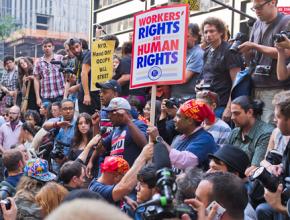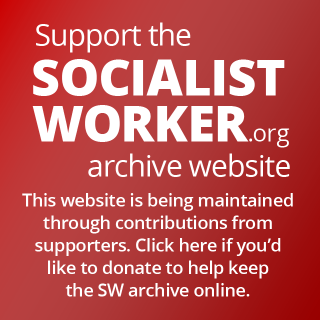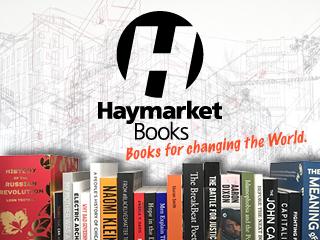Making common cause against Wall Street
Union support for Occupy Wall Street can give the movement new social power.
ORGANIZED LABOR IS weighing in on the side of the Occupy Wall Street protests--and business is taking notice of the biggest labor-left alliance since the protests against the World Trade Organization in Seattle in 1999.
The unions--"the city's most experienced agitators," as Crain's New York Business put it--are planning an October 5 rally at Foley Square near City Hall at 4:30 p.m., and then a march to Wall Street.
The entry of major unions--from the big New York affiliates of the Service Employees International Union (SEIU) to national unions such as the United Steelworkers (USW) and National Nurses United (NNU)--points to the potential for the Occupy movement to deepen its social roots. Ongoing struggles on a number of fronts--from fighting foreclosures to challenging anti-union employers to building a movement to demand jobs--can gain new energy from this mobilization.
Union officials who made the decision to back the Wall Street protests aren't simply responding to calls for solidarity for the Occupy movement, important though that is. They're also reflecting the anger among their own members over job losses, wage cuts and reductions in social spending in a worsening economy, while Corporate America rakes in record profits and the already super-rich get even richer.

That anger is what's driving Occupy Wall Street, which began less than three weeks ago with hundreds of mostly young activists rallying in Manhattan's financial district and establishing a 24-hour encampment in Zuccotti Park--renamed Liberty Plaza in honor of Egypt's Tahrir (Liberation) Square occupation--in the Lower Manhattan financial district.
The action has captured the imagination and sympathies of much larger numbers of people fed up with all the different aspects of a system run by the super-rich 1 percent, symbolized by the Wall Streets bankers and financial speculators. In New York, the regular protests and round-the-clock political discussions in Liberty Plaza keep growing larger, and activists in other cities have organized their own Occupy actions.
In short, Occupy Wall Street has become a lightning rod for all the accumulated discontent in the U.S.
THE FIGHTING spirit on display in Lower Manhattan today didn't come from nowhwere. It was also behind the uprising in Wisconsin last winter against Republican Gov. Scott Walker's union-busting, and it could be seen in many struggles since. From the lively roving pickets of the Verizon strike in August to the blockades of scab cargo by West Coast longshore workers to the defiance of a judge's order by striking teachers in Tacoma, Wash., there's a new militancy in the air, including among organized workers.
This rebellious atmosphere no doubt influenced the executive board of New York City's Transport Workers Local 100 to endorse Occupy Wall Street--it was the first major union to do so. Local 100, which represents some 30,000 bus and subway workers, has a fighting history, and endured stiff legal penalties and fines for waging an illegal three-day strike in December 2005.
Today, Local 100 leaders talk about Occupy Wall Street as a sister struggle, as union President John Samuelson explained in an interview on the TV show Countdown:
I believe to a large extent, the protesters on Wall Street are singing the same song, and fighting the same battle, that our union has fought for the last 18 months...
There's a sense of desperation, I believe, among working people and working families in this country that the folks in government just don't get. There's a lot of millionaires in Congress that have no idea--a lot of millionaires in the state legislature, for that matter--that have no idea what it's like...to have to feed kids or pay tuition or pay a mortgage. There's a lot of folks in government that are out of touch.
These protests, for one thing, have brought attention to the disparity of wealth in the United States that's developed over the past few decades. I think one of the great benefits that organized labor entering into this fight will bring is an ability to articulate that message...on behalf of working families, whether they are in unions or not in unions.
Labor's involvement in the Occupy movement isn't confined to New York City. Members of United Teachers Los Angeles joined with a community organization and the Occupy Los Angeles group to protest a local bank. In the Bay Area, SEIU Local 1021 members reached out to Occupy San Francisco early in the organizing effort. In the Midwest, members of the reform leadership of the Chicago Teachers Union showed their support for Occupy Chicago, and the Occupy activists in turn voted to endorse a previously planned October 10 protest initiated by teachers and the SEIU.
All these initiatives are highly significant for U.S. unions, which, with a few notable exceptions, have for more than a 50 years shunned almost all the activism of the radical left. From the start of the Cold War in the late 1940s until after the collapse of the USSR in the 1990s, anticommunism at home and abroad was central to U.S. labor politics.
That approach had faded by the late 1990s, and hard-pressed unions tentatively looked to allies on the left, such as environmental activists, in the struggle against corporate globalization. It was this "Teamsters and Turtles" alliance that came together in the 1999 WTO protests in Seattle, which brought out tens of thousands of union members for demonstrations that ended in a police riot.
Unfortunately, that newly born labor-left coalition collapsed under the conservative tide after the September 11, 2001 attacks. Almost every major union lined up in support of the U.S. war on Afghanistan, and some union leaders called for reviving Cold War-era labor-management "partnership" to help in the so-called "war on terror."
But backing the war effort got labor worse than nothing. Business kept hammering away at unions, wiping out manufacturing jobs and squeezing wages even during the years of economic growth in the 2000s--which left the U.S. working class even more vulnerable when the recession began in late 2007.
The union's response at this point was to pour money and resources into electing Barack Obama in 2008, in the hopes that he would champion pro-labor legislation and pursue economic policies that created jobs. But Obama, of course, made bankers his priority instead.
Certainly union leaders will again pressure their members to organize for Obama in the 2012 election--if not on the basis of hope, than because of fear of the Republican alternative.
But labor's support for the Occupy movement opens the way for a broader political life--and activism--within the labor movement. The statement by USW President Leo Gerard can be used in unions across the U.S. as the basis for a resolution of support for the Occupy movement:
The United Steelworkers union stands in solidarity with and strongly supports Occupy Wall Street. The brave men and women, many of them young people without jobs, who have been demonstrating around-the-clock for nearly two weeks in New York City are speaking out for the many in our world. We are fed up with the corporate greed, corruption and arrogance that have inflicted pain on far too many for far too long.
Labor can also help the movement focus on winning concrete gains. For example, nurses in the NNU have been organizing a "Main Street" campaign that calls for a tax on financial transactions--the union has devoted resources to the October 5 labor march at Occupy Wall Street.
LABOR'S SUPPPORT for the Occupy movement means more than additional resources or big numbers at marches and rallies, however. The involvement of unions in the struggle creates the potential to use workers' social power in the struggle to win important immediate fights, as well as a longer-term battle for a different kind of society.
Consider the experience of the labor protests at the state Capitol in Madison, Wis. It was a mass sickout by schoolteachers in Madison--and then across the state--that transformed what had been a mostly student sit-in into a round-the-clock Capitol occupation organized by workers and students alike. Union leaders ultimately shied away from using workers' economic power to win that fight, focusing instead on an effort to recall Republican legislators. But the potential for widening the struggle was there--with a general strike the topic of serious discussion among union activists.
The Occupy movement provides a similar opportunity to revive and build critical links between labor and the left--in order to take action. There's the potential to mobilize for important fights like the battle to save the jobs of 716 teachers aides in heavily Black and Latino schools in poor New York City neighborhoods. The movement can provide a focal point for individual union militants who may have felt isolated in their own unions and workplaces, and it can help revive rank-and-file networks within and between unions.
For the nearly 90 percent of workers who are not in unions, the Occupy movement can provide the impetus to organize their own workplaces. And all movement activists--whether union members or not--can play a crucial role in building support for labor in the contract showdowns that loom ahead, from teachers in Chicago and Los Angeles to the bus and subway workers in New York City.
At a time when the economic crisis once again has top business figures and politicians on the verge of panic, it's important for the movement to project its own vision of a society based on human need rather than profits. Activists need to discuss and debate their priorities and strategies at a local level.
But they should also focus on the big picture--reviving a working-class movement that is capable of defending the interests of all the have-nots in the struggle against the 1 percent.


